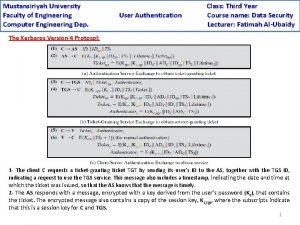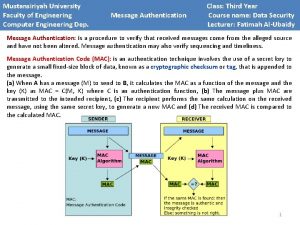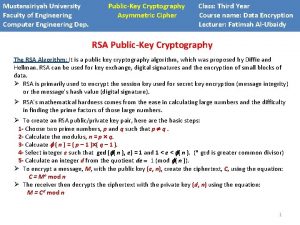Mustansiriyah University Faculty of Engineering Computer Engineering Dep





- Slides: 5

Mustansiriyah University Faculty of Engineering Computer Engineering Dep. Malicious Software Class: Third Year Course name: Data Security Lecturer: Fatimah Al-Ubaidy Malicious software, or malware A program that is inserted into a system, usually covertly, with the intent of the confidentiality, integrity, or availability of the victim’s data, applications, or operating system or otherwise annoying or disrupting the victim. In other words, malicious software is software that is intentionally included or inserted in a system for a harmful access. Ø Malicious software can be divided into two categories: those that need a host program, and those that are independent. The former, referred to as parasitic, are essentially fragments of programs that cannot exist independently of some actual application program, utility, or system program such as viruses. Ø Independent malware is a self-contained program that can be scheduled and run by the operating system such as worms. Ø We can also differentiate between those software threats that do not replicate and those that do. The former are programs or fragments of programs that are activated by a trigger such as logic bombs. Ø The latter consist of either a program fragment or an independent program that, when executed, may produce one or more copies of itself to be activated later on the same system or some other system such as viruses and worms. 1

Mustansiriyah University Faculty of Engineering Computer Engineering Dep. Malicious Software Class: Third Year Course name: Data Security Lecturer: Fatimah Al-Ubaidy Trojan Horses A Trojan horse is a useful, or apparently useful, program or command procedure containing hidden code that, when invoked, performs some unwanted or harmful function. Trojan horse programs can be used to accomplish functions indirectly that an unauthorized user could not accomplish directly. For example, to gain access to the files of another user on a shared system, a user could create a Trojan horse program that, when executed, changes the invoking user’s file permissions so that the files are readable by any user. v Another common motivation for the Trojan horse is data destruction. The program appears to be performing a useful function (e. g. , a calculator program), but it may also be quietly deleting the user’s files. v Trojan horses fit into one of three models: 1 - Continuing to perform the function of the original program and additionally performing a separate malicious activity. 2 - Continuing to perform the function of the original program but modifying the function to perform malicious activity (e. g. , a Trojan horse version of a login program that collects passwords). 3 - Performing a malicious function that completely replaces the function of the original program. Viruses A computer virus is a piece of software that can “infect” other programs by modifying them; the modification includes injecting the original program with a routine to make copies of the virus program, which can then go on to infect other programs. 2

Mustansiriyah University Faculty of Engineering Computer Engineering Dep. Malicious Software Class: Third Year Course name: Data Security Lecturer: Fatimah Al-Ubaidy Ø A virus can do anything that other programs do. The difference is that a virus attaches itself to another program and executes secretly when the host program is run. Once a virus is executing, it can perform any function, such as erasing files and programs. Ø E-Mail Viruses: The first rapidly spreading e-mail viruses, such as Melissa, made use of a Microsoft Word macro embedded in an attachment. If the recipient opens the e-mail attachment, the Word macro is activated. Then 1. The e-mail virus sends itself to everyone on the mailing list in the user’s e-mail package. 2. The virus does local damage on the user’s system. Ø In 1999, a more powerful version of the e-mail virus appeared. This newer version can be activated merely by opening an e-mail that contains the virus rather than opening an attachment. The virus uses the Visual Basic scripting language supported by the e-mail package. Virus Countermeasures: Antivirus Approaches: The ideal solution to the threat of viruses is prevention: Do not allow a virus to get into the system in the first place, or block the ability of a virus to modify any files containing executable code. The next best approach is to be able to do the following: • Detection: Once the infection has occurred, determine that it has occurred and locate the virus. • Identification: Once detection has been achieved, identify the specific virus that has infected a program. • Removal: Once the specific virus has been identified, remove all traces of the virus from the infected program and restore it to its original state. Remove the virus from all infected systems so that the virus cannot spread further. 3

Mustansiriyah University Faculty of Engineering Computer Engineering Dep. Malicious Software Class: Third Year Course name: Data Security Lecturer: Fatimah Al-Ubaidy WORMS A worm is a program that can replicate itself and send copies from computer to computer across network connections. Upon arrival, the worm may be activated to replicate and propagate again. In addition to propagation, the worm usually performs some unwanted function. An e-mail virus has some of the characteristics of a worm because it propagates itself from system to system. Mobile Phone Worms first appeared on mobile phones in 2004. These worms communicate through Bluetooth wireless connections or via the multimedia messaging service (MMS). The target is the smartphone, which is a mobile phone that permits users to install software applications from sources other than the cellular network operator. Mobile phone malware can completely disable the phone, delete data on the phone, or force the device to send costly messages to premium-priced numbers. Denial of service (Dos) attack: A Dos attack is an attempt to prevent legitimate users of a service from using that service Spyware: it collects information from a computer and transmits it to another system. . It usually aims to track and sell your internet usage data, capture your credit card or bank account information, or steal your personal identity. Adware: is a software that can result in unwanted ads or redirection of a browser into a commercial site. It generates revenue for its developer by automatically generating online advertisements in the user interface of the software or on a screen presented to the user during the installation process. 4

Mustansiriyah University Faculty of Engineering Computer Engineering Dep. Malicious Software Class: Third Year Course name: Data Security Lecturer: Fatimah Al-Ubaidy Terminologies 5









